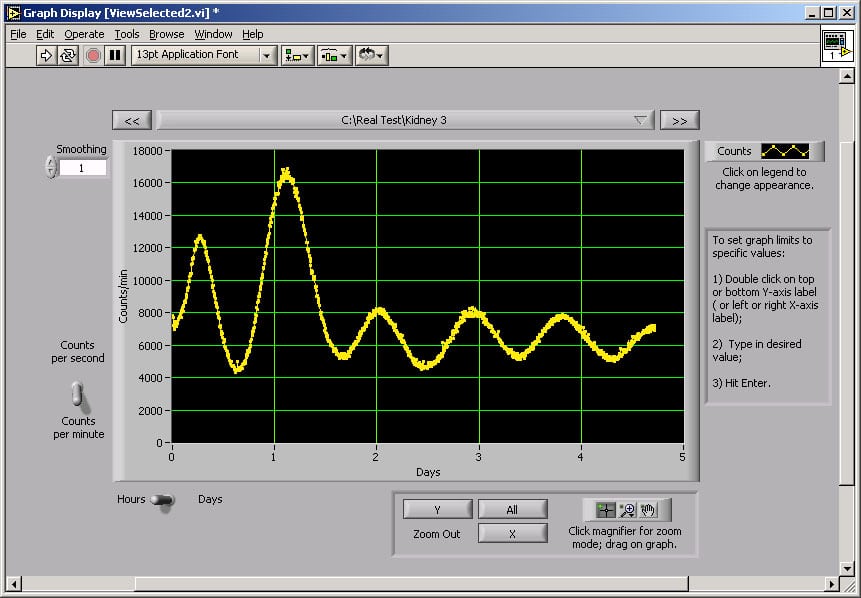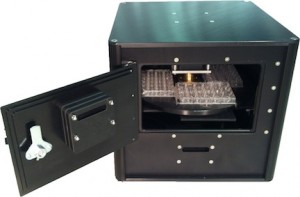LumiCycle 96
96-Channel Luminometer for Circadian Biology
Like LumiCycle 32, LumiCycle 96 performs high-throughput luminometry on self-luminous tissues, such as from PER-LUC mutants. LC96 records from 4 24-well plates. The system is equipped with 8 photomultiplier tubes, each selected for low dark counts and high sensitivity in the green portion of the spectrum at which luciferase emits light. A turntable and moving PMT mounting alternately brings each sample under its detector. (Specifications.)
LumiCycle 96 is identical in size to LumiCycle 32. The apparatus fits inside a standard incubator. An internal fan circulates the incubator air to maintain the proper temperature within the chamber. The temperature is therefore as stable as the incubator can make it. The turntable and photon counting are fully automated. System setup and operation is straightforward. Online help files are included with the software.
Comparison of 96-channel and 32-channel systems:
- In LC96, 12 samples share each PMT (instead of 8), so that each sample is counted for 2/3 less time during each hour.
- The PMTs in LC96 are “end-on” instead of “side-on”.
- The PMTs in LC96 have a larger window, which increases the background signal (dark counts) by about 2-fold, but also increases the signal itself by a comparable amount.
- The light-tight cabinets are identical in size.
- LC96 uses two USB slots on the host computer (instead of one).
- File formats and analysis software are identical.
- Both systems have very low cross-talk between channels. In LC96 cross-talk is less than 1 part in 1000.
In addition to its high-precision photon counting hardware, LumiCycle has the most flexible and easy-to-use software for the collection and analysis of circadian rhythms in luminometry data. As with LC32, recording is continuous; recording on each 24-well plate can be started and stopped independently.
 Start and stop each counting channel asynchronously. You may, for example, start one experiment with 10 samples on one day, and start a second experiment with 22 samples the following day, stop the first experiment 5 days later and start yet a third set of dishes in their place.
Start and stop each counting channel asynchronously. You may, for example, start one experiment with 10 samples on one day, and start a second experiment with 22 samples the following day, stop the first experiment 5 days later and start yet a third set of dishes in their place.- Interrupt the data collection to perform experimental manipulations on the samples (such as adding a drug). Once the treatment is complete, LumiCycle will pick up exactly where it left off.
- Flexible counting schedules, from once per hour, to once per minute.
- View records during the data collection process. A single window shows data for all 32 channels at once. Double-click on one of the graphs to view the data in greater detail (top figure).
- Analysis program (bottom figure) automatically compensates for baseline shifts and signal attenuation over the course of the trial. The dominant circadian period and phase can then be extracted (red curve). View periodograms and actograms, calculate phase shifts, extract periods with spectral or periodogram methods.
- Superimpose multiple records for comparison and figure preparation.

- Calculate rhythm parameters for the complete record, or for multiple subsets of the record. If, for example, a treatment is given halfway through a record that is expected to create a period or phase change, the two halves of the record can be analyzed separately and a phase shift calculated.
- While data collection is in progress, you may repeatedly copy the growing data files onto another computer (via a floppy or the network) and analyze the data collected so far for period and phase. Data collection continues uninterrupted until the end of the experiment.
- Extracted periods and phases can be exported to a text file for later manipulation in Excel or other statistics programs.
- Raw or baseline-subtracted records can be exported to ClockLab for further analysis using periodograms, actograms, and activity profiles.

